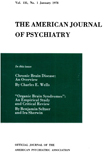PATTERNS OF BEHAVIOR DISTURBANCE FOLLOWING CATARACT EXTRACTION
Abstract
1. Twenty-one consecutive ward patients admitted to the ophthalmologic service for senile cataract extraction were studied by a team of observers. Each patient was given an EEG and an amytal test for organic brain disease. Prior to operation each patient was masked for a period of at least 12 hours.
2. One patient was manifestly psychotic on admission. The others showed varying degrees of anxiety that could be related largely to insecurities attendant on old age and loss of vision. The preoperative masking produced changed behavior in 10 patients, ranging from insomnia and verbal expressions of anxiety to acute panic reactions. Removal of the mask relieved the anxiety.
3. Following the operation 20 patients showed some alteration in behavior including changes in mood, psychomotor disturbances, paranoid and somatic delusions, hallucinations, disorientation and confabulations. In 3 cases the disturbance was characterized as severe. Unmasking resulted in prompt improvement in 6 cases, gradual improvement in 48 hours in 3. Only 4 patients continued to show disturbances after the mask was removed; in each some physical complication was present. In 2 patients abnormal behavior appeared for the first time after unmasking.
4. Some degree of organic brain disease, as shown by the EEG and amytal test, was present in 18 patients. There appeared to be a relationship between the presence and degree of brain damage and the development of disturbed behavior. The findings suggested that senile cataract may be one manifestation of a more extensive degenerative process. Older patients are more apt to show disturbances. The premorbid personality pattern seemed to be unrelated to the incidence of altered behavior, but to some extent determined the particular type of pattern exhibited.
5. It is concluded that disturbed behavior is an integral part of the reaction of almost all cataract patients because of a complex interaction of a number of factors. The implication of these findings for prophylaxis and management is discussed.
Access content
To read the fulltext, please use one of the options below to sign in or purchase access.- Personal login
- Institutional Login
- Sign in via OpenAthens
- Register for access
-
Please login/register if you wish to pair your device and check access availability.
Not a subscriber?
PsychiatryOnline subscription options offer access to the DSM-5 library, books, journals, CME, and patient resources. This all-in-one virtual library provides psychiatrists and mental health professionals with key resources for diagnosis, treatment, research, and professional development.
Need more help? PsychiatryOnline Customer Service may be reached by emailing [email protected] or by calling 800-368-5777 (in the U.S.) or 703-907-7322 (outside the U.S.).



